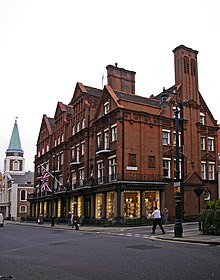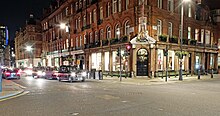
South Audley Street is a major shopping street in Mayfair, London. It runs north to south from the southwest corner of Grosvenor Square to Curzon Street.
History

The street is named after Hugh Audley, whose heirs acquired the land following Sir Thomas Grosvenor's marriage to Mary Davies in 1677. Construction of properties along the street began in 1720, initially with small houses at the north end and larger family residences to the south. This reflected a social convention that was common at this time.
Audley Square was a short abutment at the south end of the street. Unlike other significant squares in Mayfair, it was three sided and had no garden. The first multistorey car park in the City of Westminster opened here in 1962.
Caroline of Brunswick (consort of King George IV) briefly stayed at No. 77 South Audley Street after returning from Italy in 1820. She was considered a popular queen and appeared at the balcony of the house to cheering crowds.
South Audley Street was redeveloped between 1875 and 1900, when most of the smaller buildings to the north were demolished and rebuilt as shops with residences above them. However, several buildings (Nos. 9–16 and 71–75 consecutive) all survive from the 1730s.
Properties

The Grosvenor Chapel is a Grade II* listed chapel on South Audley Street, and the only remaining original property on the north part of the street. It was built by Benjamin Timbrell in 1730, and became a chapel of ease for St George's Hanover Square Church in 1831. During World War II it was used by American armed forces. The parents of Arthur Wellesley, 1st Duke of Wellington are buried in the church.
Chesterfield House was a grand house on South Audley Street built by Isaac Ware for Philip Stanhope, 4th Earl of Chesterfield between 1747 and 1750. It was demolished in 1937.
Leconfield House is at the corner of South Audley Street and Curzon Street. It is best known for being the former headquarters of MI5.
Thomas Goode's tableware shop was first established in 1844 at No. 17. It gradually expanded throughout the 19th century; the current premises at Nos. 17–22 was constructed between 1875 and 1891 by Ernest George.

The Qatari embassy is at No 1. It has been Grade II listed since 1970.
Gunsmiths James Purdey & Sons was established at Nos. 57–60 in 1881.
The private member's dining club Harry's Bar was established at No. 26 in 1979.
References
Citations
- ^ 'South Audley Street: Introduction', in Survey of London: Volume 40, the Grosvenor Estate in Mayfair, Part 2 (The Buildings), ed. F H W Sheppard (London, 1980), pp. 290–291. British History Online http://www.british-history.ac.uk/survey-london/vol40/pt2/pp290-291
- ^ Weinreb et al. 2008, p. 850.
- Weinreb et al. 2008, pp. 850–851.
- Girling, Brian (2012). Mayfair Through Time. Amberley. p. 76. ISBN 978-1-445-62949-0.
- ^ Weinreb et al. 2008, p. 851.
- "Richard Dighton". National Portrait Gallery. Retrieved 30 October 2019.
- Historic England (24 February 1958). "The Grosvenor Chapel (1236429)". National Heritage List for England. Retrieved 26 October 2019.
- Weinreb et al. 2008, p. 358.
- "Plan of the ground floor of the Rt. Honble [sic] the Earl of Chesterfield's House in May Fair". British Library. Retrieved 27 October 2019.
- Berkeley 1994, p. 333.
- Historic England (5 February 1970). "1, South Audley Street W1 (1264645)". National Heritage List for England. Retrieved 26 October 2019.
- "James Purdey & Sons Ltd, 57–58 South Audley Street, Marylebone St Johns Wood And Mayfair, Greater London". Historic England. Retrieved 26 October 2019.
- Susan Heller Anderson (12 December 1979). "The London That Comes to Life at Midnight". The New York Times. Retrieved 23 April 2022.
Sources
- Berkeley, Roy (1994). A Spy's London. Pen and Sword. ISBN 978-0-850-52113-9.
- Weinreb, Ben; Hibbert, Christopher; Keay, John; Keay, Julia (2008). The London Encyclopaedia (3rd ed.). Pan Macmillan. ISBN 978-1-405-04924-5.
External links
 Media related to South Audley Street at Wikimedia Commons
Media related to South Audley Street at Wikimedia Commons
51°30′31″N 00°09′05″W / 51.50861°N 0.15139°W / 51.50861; -0.15139
Categories: